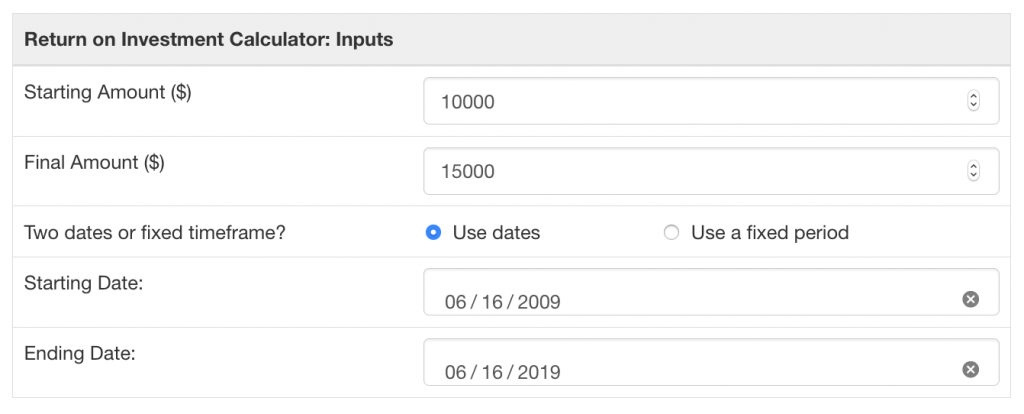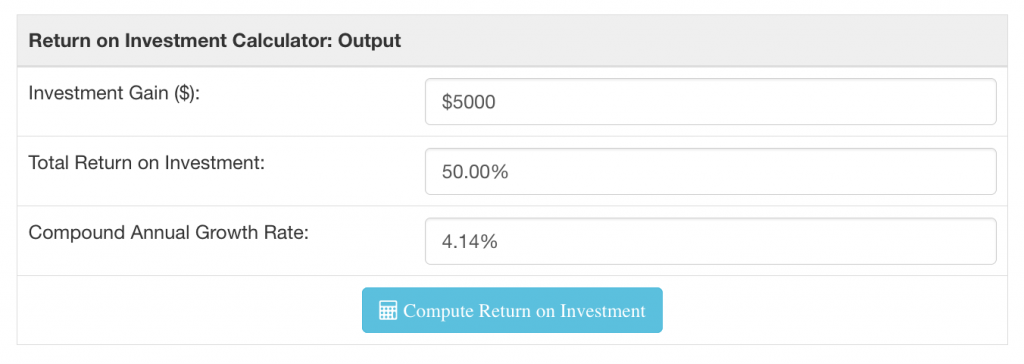On this page is a return on investment calculator, often abbreviated ROI.
Enter a beginning and ending amount and time-frame and we'll compute your return on investment. Also, we'll calculate your annual return and absolute investment gain or loss.
Return on Investment Calculator
Using the Calculator

- Starting Amount - The initial value of the investment
- Final Amount - The value at the end of the time period
- Two dates or fixed timeframes? - Enter a range of time by picking a start and end date or entering a number of years
- (Two Dates) Enter Starting Date and Ending Date
- (Fixed Timeframes) Enter Number of Years (you can use decimals)
- CAGR/Return per Period - The percentage gained as a compound annual growth rate or CAGR ('per period' normalized growth)

- Investment Gain - The total earnings or loss on the investment, i.e. the final value minus the starting value
- Total Return on Investment - The total percentage gain (the true ROI) on the investment over the entire timeframe
- Compound Annual Growth Rate - The value of the total return when converted to an annual gain or loss
What is Return on Investment?
Return on Investment is one measure of an investment's profitability. By taking the earnings on an investment and dividing it into the initial outlay, the remaining percentage is the return on investment.
ROI is often quoted as the percentage gain in some investment, or alternatively the total return (measured in dollars or some other currency) net of an initial investment.
How does ROI differ from CAGR – compound annual growth rate?
CAGR or compound annual growth rate is a normalized measure of your investment's performance. Since money invested in one place is not invested elsewhere, CAGR is a fair way to compare two investments by the rate they return gains quoted as an average gain or loss per year.
CAGR is a useful lens for you to compare investment returns (and why we included both ROI calculations and CAGR in the ROI calculator).
Visit our compound annual growth rate calculator for a longer discussion on CAGR.
Return on Investment Formula
The basic return on investment formula is:
\frac{(final\ value - initial\ investment)}{initial\ investment} * 100 = ROIThe last step – multiplying by 100 – is just to convert the result into an easy-to-quote percentage.
Annualized ROI
Annualized ROI is effectively the same thing as compound annual growth rate.
Quickly, you can compute your annual percentage return on investment with this formula:
({\frac{final\ value}{initial\ value}})^{\frac{1}{years}} -1*100 = ROIAs in the above ROI formula section, the *100 step is just convenience for quoting a percentage. The result is "X% per year" return.
Absolute Return on Investment
Absolute return on investment isn't much of a formula.
Really – just subtract your initial investment from your final value. That result is the actual return on investment, positive or negative.
final\ value - initial\ investment = final\ ROI
Even though it isn't much of a formula, your absolute return is arguably the most important number here. Well – it is according to most governments.
In the United States, you are taxed on your capital gain (or save taxes on a capital loss). Regardless of your percentage ROI, value at risk, time in the market, etc, capital gains taxes apply.
(Capital gains also ignore inflation in most places).
ROI Calculation Example
Let's walk through all three of the relevant formulas above in a simple ROI calculation example. I'll draw it out manually, but you should also use the above tool for clarity.
Let's make the following assumptions:
- Initial investment: $1,000
- Final value: $3,000
- Time in market: 3 years
Let's compute all of the return on investment numbers we care about.
Absolute Return on Investment
First, let's look at the absolute return on investment, or "earnings". (For individual investments in the United States, this is your capital gain or capital loss).
- Earnings = $3000 - $1000
- Earnings = $2000
Excellent – ignoring time, this investment made you $2,000. Let's move onto ROI.
Return on Investment
Now, let's look at the core number for return on investment, or the percentage gain (or loss). From the above formula, (final value - initial investment) simplifies to earnings so we can use the above $2,000 directly in the formula.
- ROI = ($2,000 / $1,000) * 100
- ROI = 200%
So, you made a 200% ROI – nice work. Now, let's look at how you performed over time. We'll use years as the period since it's the most popular way to compare results.
Annual Return on Investment (Compound Annual Growth Rate)
Now, let's take that 200% return, or $3,000 in final value on $1,000 investment, and look at the return annually.
- CAGR = ((($3,000 / $1,000) ^ (1/3))-1) * 100
- CAGR = ((3 ^ (1/3))-1) * 100
- CAGR = (1.44224957031-1) * 100
- CAGR = 44.225% annual return
Wow, that's a great investment – you made an average 44.225% annual return in this scenario. That's much higher than the historical average on the S&P 500, for example.
And there you have it. After working through the parameters for return on investment you now have:
- Absolute return on investment or capital gains to report on taxes
- Return on investment percentage to see your total return
- Annual return on investment or compound annual growth rate to compare to other investments
Other Financial Calculators
To drink from the DQYDJ calculator firehose, try all our finance calculators. If you're in the mood for similar content, see these other tools in our financial basics series:
- Present Value Calculator (with the Present Value Formula)
- Bond Pricing Calculator
- Bond Yield to Maturity Calculator
- Compound Interest Calculator (and formula)
- Compound Annual Growth Rate (CAGR) Calculator
- IRR Calculator
- XIRR Calculator
